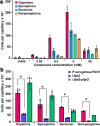Pseudomonas aeruginosa Performs Chemotaxis to the Neurotransmitters Serotonin, Dopamine, Epinephrine and Norepinephrine
- PMID: 40387537
- PMCID: PMC12087296
- DOI: 10.1111/1751-7915.70161
Pseudomonas aeruginosa Performs Chemotaxis to the Neurotransmitters Serotonin, Dopamine, Epinephrine and Norepinephrine
Abstract
Bacteria use chemotaxis to move to favourable ecological niches. For many pathogenic bacteria, chemotaxis is required for full virulence, particularly for the initiation of host colonisation. There do not appear to be limits to the type of compounds that attract bacteria, and we are just beginning to understand how chemotaxis adapts them to their lifestyles. Quantitative capillary assays for chemotaxis show that P. aeruginosa is strongly attracted to serotonin, dopamine, epinephrine and norepinephrine. Chemotaxis to these compounds is greatly decreased in a mutant lacking the TlpQ chemoreceptor, and complementation of this mutant with a plasmid harbouring the tlpQ gene restores wild-type-like chemotaxis. Microcalorimetric titrations of the TlpQ sensor domain with these four compounds indicate that they bind directly to TlpQ. All four compounds are hormones and neurotransmitters that control a variety of processes and are also important signal molecules involved in the virulence of P. aeruginosa. They modulate motility, biofilm formation, the production of virulence factors and serve as siderophores that chelate iron. Additionally, this is the first report of bacterial chemotaxis to serotonin. This study provides an incentive for research to define the contribution of chemotaxis to these host signalling molecules to the virulence of P. aeruginosa.
Keywords: Pseudomonas aeruginosa; catecholamine; chemoreceptor; chemotaxis.
© 2025 The Author(s). Microbial Biotechnology published by John Wiley & Sons Ltd.
Conflict of interest statement
The authors declare no conflicts of interest.
Figures


Similar articles
-
Pseudomonas aeruginosa Performs Chemotaxis to All Major Human Neurotransmitters.Microb Biotechnol. 2025 Aug;18(8):e70211. doi: 10.1111/1751-7915.70211. Microb Biotechnol. 2025. PMID: 40836196 Free PMC article. Review.
-
High-Affinity Chemotaxis to Histamine Mediated by the TlpQ Chemoreceptor of the Human Pathogen Pseudomonas aeruginosa.mBio. 2018 Nov 13;9(6):e01894-18. doi: 10.1128/mBio.01894-18. mBio. 2018. PMID: 30425146 Free PMC article.
-
Opportunistic use of catecholamine neurotransmitters as siderophores to access iron by Pseudomonas aeruginosa.Environ Microbiol. 2022 Feb;24(2):878-893. doi: 10.1111/1462-2920.15372. Epub 2021 Jan 14. Environ Microbiol. 2022. PMID: 33350053
-
Epinephrine affects motility, and increases adhesion, biofilm and virulence of Pseudomonas aeruginosa H103.Sci Rep. 2019 Dec 27;9(1):20203. doi: 10.1038/s41598-019-56666-7. Sci Rep. 2019. PMID: 31882963 Free PMC article.
-
Neuronal pathways and neurotransmitters in septum pellucidum of rat.Endocrinol Exp. 1976;10(3):225-40. Endocrinol Exp. 1976. PMID: 10154 Review. No abstract available.
Cited by
-
Pseudomonas aeruginosa Performs Chemotaxis to All Major Human Neurotransmitters.Microb Biotechnol. 2025 Aug;18(8):e70211. doi: 10.1111/1751-7915.70211. Microb Biotechnol. 2025. PMID: 40836196 Free PMC article. Review.
References
-
- Boujnane, M. , Boukerb A. M., and Connil N.. 2024. “Bacterial Gene Expression in Response to Catecholamine Stress Hormones.” Current Opinion in Endocrine and Metabolic Research 36: 100543.
MeSH terms
Substances
Grants and funding
LinkOut - more resources
Full Text Sources

